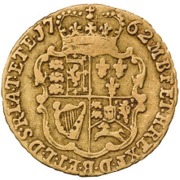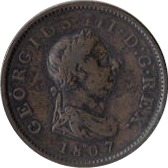 The 1762 Quarter-Guinea
The 1762 Quarter-Guinea The Quarter-Guinea was only issued twice: once in 1718 (George I), and once in 1762 (George III) when the mint decided to ignore all the reasons why the 1718 mintage was not repeated. The story was the same in both cases.
The Guinea at the time was valued at 21 shillings (one pound and one shilling). According to an inflation calculator, one pound (20 shillings) would be worth about £206 in today's terms, so a Guinea was an lot of money and there was a need for smaller denominations.
Thus, the Quarter Guinea. Worth 5/3d (five shillings and three pence) it was a more manageable value, equivalent to a £50 note these days, but even so a sizeable amount. This would be OK as a large silver coin like a Crown, but as silver had risen in price considerably at the time it was decided that the Quarter Guinea should be a gold coin.
You can read more details in our article The Quarter-Guinea and Other Problems.
To keep the proportions of the Guinea and Half-Guinea, the Quarter Guinea was therefore a small 22 carat gold coin with a diameter of 16mm and a weight of 2.1g. To compare, that is 2mm smaller than a modern 5p coin (which weighs 3.25g).
Imagine today having a £50 coin that small? You'd be terrified of losing it, and back in 1762 they were too. It was very unpopular. The Quarter-Guinea was never made again.
 Despite the small size, the coin itself packed as much detail as the Guinea coin itself.
Despite the small size, the coin itself packed as much detail as the Guinea coin itself. The Obverse shows the portrait of George III by Richard Yeo (~1720–1779).
The Reverse is a large and elaborate crowned shield. Some call this a "Four-fold arms design".
The massive inscription is "M B F ET H REX F D B ET L D S R I A T ET E" (plus the date "1762") meaning "King of Great Britain, France, and Ireland; Defender of the Faith, Duke of Brunswick and Lüneburg, Arch-Treasurer and Elector of the Holy Roman Empire".
I have read that about 1,135,000 Quarter Guineas were minted, although many may have been soon re-melted due to its unpopularity. You see them on sale in F to EF condition for about £200-£900.
Images used by permission of The Royal Mint
Mintage: 1,135,000 (may include coins in sets)
Minted at The Royal Mint
Below are some coins currently being offered on eBay. As an eBay Partner, We may be compensated if you make a purchase.
 Born on 4 June 1738 to Frederick, Prince of Wales and Augusta of Saxe-Gotha in the house of Hanover, George III reigned for over 59 years.
Born on 4 June 1738 to Frederick, Prince of Wales and Augusta of Saxe-Gotha in the house of Hanover, George III reigned for over 59 years.George had 15 children - nine sons and six daughters. In the latter part of his life George suffered from a mental illness and his son George became Prince Regent from 1811-1820 and ruled on his behalf. On George III's death, the Prince Regent became George IV.
Note the latin spelling of George on his coins: Georgivs.
The Guinea is a famous British gold coin minted between 1663 and 1814. The coin was originally created as a one pound coin (20 shillings) but is better known as being worth One Pound and One Shilling (21 shillings).
After the English Civil War, King Charles II introduced new coinage. A gold coin, approximately a quarter of an ounce, was issued and for the first time it was not hammered. Made by machine using gold from the Guinea Coast of West Africa the coin probably became the most important coin of the realm.
Originally 20 shillings, the coin actually fluctuated with the gold price, at times being as high as 30 shillings. In 1717 the Guinea became fixed at 21 shillings (in today’s money that is £1.05). Other coins of the family were also minted, such as half-guinea, two-guinea and five-guinea.
The design of gold guinea changed dramatically over the years, from depictions of crowned cruciform shields to the ‘Spade’ shaped crowned shields of arms.
In the Great Recoinage of 1816 the Guinea was replaced by the Pound and the Sovereign became the gold coin in use. The last guinea was issued during the reign of King George III in 1813. That particular coin is known as a ‘Military’ guinea, as it was specially struck to pay British troops at the time of the Napoleonic Wars.
Long after the Guinea was retired the name continued to be used, especially for prestige purchases intended for the more wealthy. Even now racehorses are still sold in Guineas (the auctioneer traditionally taking the 5p as commission).
Guineas are 25mm in diameter, weigh about 8.38g and are 22 carat gold (91.6%). Prior to 1717 they weighed slightly less (around 8.3g) and were made of 91.34% gold.
Millions of gold guineas were minted and widely circulated, so often turn up in fine to very fine condition. As with all coin types, some years are much rarer than others, such as the 1761 guinea (as it was the first guinea minted during the reign of King George III).
Formed in the reign of Alfred the Great about the year 886, during the period 1279-1812 it was generally referred to as The Tower Mint as it was housed at the Tower of London. The Master of The Royal Mint has included famous figures such as Sir Isaac Newton.
Since 2010 it has operated as Royal Mint Ltd, a company owned by HM Treasury, under an exclusive contract to supply all coinage for the UK although it also produces medals and coins for other countries. It is currently located at Llantrisant, Wales.
The orignal coinage was Pounds, Shillings and Pence but since decimalisation on 15 February 1971, it is £1 = 100p, that is One Pound = 100 pence. The coinage of the UK is also a long history, the Royal Mint being established as long ago as 886AD when coins were hammered. Today there is perhaps 30 billion coins in circulation, and many (numismatic) collectors coins and sets are issued frequently in gold, silver and other metals.








